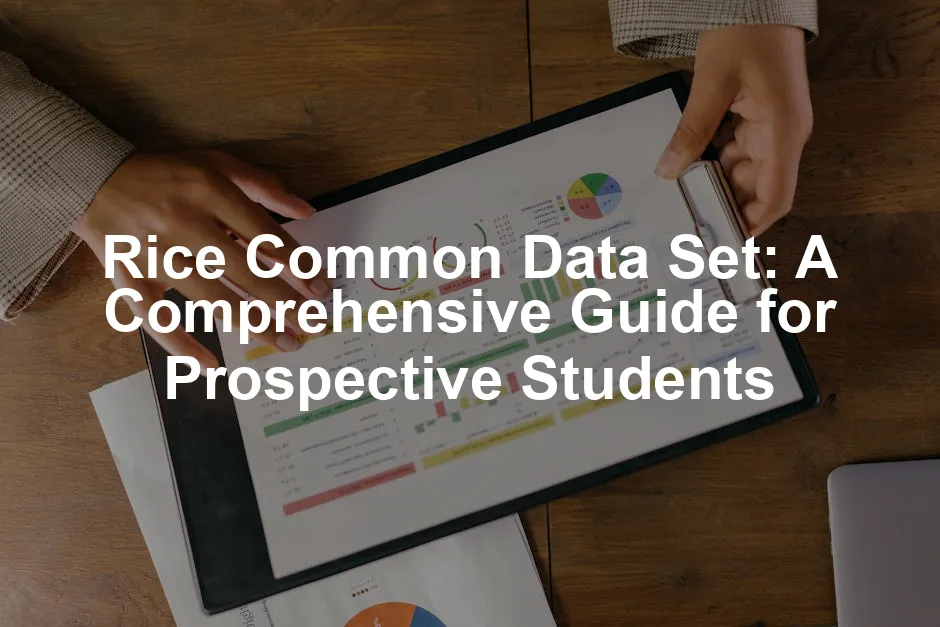Introduction
Are you considering applying to Rice University? If so, the Rice Common Data Set (CDS) is a vital resource for you. The CDS offers standardized information about the university, aiding your college search. By providing clear data on admissions, financial aid, and more, it helps you make informed decisions about your future. Let’s uncover the details of the Rice CDS together.
Summary and Overview
The Common Data Set is a standardized tool used in higher education. Its main purpose is to streamline the reporting process for colleges and universities. By offering a clear framework, it allows for easy comparisons between institutions. This is particularly helpful for prospective students like you!
The Rice CDS holds unique significance. It provides essential data that helps applicants and stakeholders understand the university better. Within the Rice CDS, you’ll find crucial information such as admissions statistics, enrollment figures, and financial aid details. This data empowers you to evaluate your fit for Rice University.

As you embark on this journey, consider getting a College Application Planner. It can help you stay organized, manage deadlines, and reduce the chaos of applying to multiple colleges. After all, who wants to juggle essays and recommendations while trying to remember if they’ve sent their transcripts? Not you!
Understanding the Common Data Set (CDS)
What is the Common Data Set?
The Common Data Set is a collaborative effort among colleges and educational publishers. It aims to enhance the quality of information available to students and parents. Historically, organizations like the College Board and U.S. News & World Report have been involved in this initiative.
By offering standardized data, the CDS ensures that information across institutions is comparable. This helps prospective students like you navigate the complex landscape of college admissions with ease. Understanding the CDS is your first step toward making a well-informed college choice.
Importance of the Rice Common Data Set
The Rice Common Data Set (CDS) serves as a crucial tool for prospective students. It provides a clear snapshot of what Rice University offers. This information helps you understand if Rice aligns with your academic and personal goals.
First, the CDS highlights key benefits for applicants. It includes vital statistics, such as acceptance rates and academic profiles. This allows you to gauge your competitiveness. By understanding the data, you can tailor your application accordingly.
Moreover, the CDS reflects institutional priorities. It outlines what Rice values in applicants. This knowledge gives you insight into their admissions philosophy. Knowing what matters most can enhance your application strategy.
Transparency is another essential aspect. The CDS promotes openness in the admissions process. When institutions share detailed information, it builds trust. You can feel more confident in your application journey. Ultimately, the Rice CDS is an invaluable resource for making informed decisions.
To keep your study materials organized, consider investing in a Desk Organizer. It’s a simple yet effective way to keep your study space tidy and your mind clear. Plus, it reduces the likelihood of losing that all-important acceptance letter under a pile of papers!
Key Components of the Rice Common Data Set
Admissions Statistics
Rice University’s admissions statistics provide a clear picture of the applicant pool. For the 2024 admissions cycle, Rice received 29,544 applications. Out of these, 2,802 students were offered acceptance, yielding an acceptance rate of just 9.5%. This figure underscores the competitiveness of Rice.
Understanding these numbers is crucial for prospective applicants. It helps you assess your chances based on your academic background. Familiarizing yourself with these statistics can guide you in presenting a strong application.

Academic Requirements and Evaluation Criteria
Academic factors are pivotal in the admissions process at Rice. The evaluation criteria consider GPA, standardized test scores, and personal essays. Each of these components plays a significant role in your overall application.
The “Basis for Selection” section of the CDS is particularly enlightening. It ranks the importance of various criteria. According to the Rice admissions office, the rigor of your coursework and GPA are crucial. Essays and extracurricular activities also hold significant weight. Understanding these aspects can help you focus on what truly matters in your application.
If you’re looking to ace those standardized tests, grab a Study Guide for Standardized Tests. It’s like having a personal trainer for your brain, helping you muscle through the toughest questions and prep like a champ!
Financial Aid and Cost of Attendance
Financial considerations are vital for many students. The Rice CDS outlines tuition, fees, and financial aid statistics. For the 2023-2024 academic year, the total cost of attendance is approximately $69,932. This figure includes tuition, room, and board, along with other expenses.
Rice offers various financial aid options. These include need-based and non-need-based scholarships. Knowing the financial landscape can help you plan your education journey. Understanding these details allows you to explore available resources effectively, ensuring you make informed decisions about financing your education at Rice.

To keep your finances in check, consider picking up a Personal Finance Book for Students. It’ll help you navigate the treacherous waters of budgeting, saving, and spending wisely, so you can enjoy your college years without breaking the bank!
Student Demographics and Diversity
Rice University prides itself on its diverse student body. In recent years, the composition of students has reflected a rich tapestry of backgrounds. This diversity includes a healthy balance of gender and ethnic representation.
According to the latest data, the undergraduate population consists of approximately 51.8% male and 48.2% female students. Ethnic diversity is equally notable. For instance, around 14.5% identify as Hispanic or Latino, while 7.2% are Black or African American. The Asian community makes up about 28.1% of the student body. This variety enhances the learning experience, bringing unique perspectives into discussions and collaborations.

Why does this matter? Diversity fosters an inclusive environment. It enriches classroom conversations and encourages innovative thinking. Students benefit from exposure to different cultures and viewpoints. This broadens their understanding of global issues.
Statistics like these not only reflect Rice’s commitment to diversity but also help prospective students gauge the community they may join. Understanding the demographics provides insights into the campus culture and social dynamics.
To celebrate that diversity, why not add some Wall Art for Dorm Decoration? It can make your living space feel more personal and inviting, showcasing your unique style and interests!
Popular Majors and Academic Programs
When considering Rice University, it’s essential to know which majors are most popular among students. Based on the latest Common Data Set data, some of the top programs include Engineering, Social Sciences, and Computer Science. These fields attract students eager to make significant impacts in their respective areas.
Selecting a major is a critical decision for prospective students. It influences academic focus and career trajectories. Choosing a popular major may offer networking opportunities and access to resources. However, it’s vital to balance personal interest with potential job market trends.

For example, Engineering represents 14.4% of degrees conferred, while Social Sciences account for 14.1%. This information can guide your decision-making process. You want to ensure your major aligns with your passion and career goals.
Ultimately, understanding these popular programs at Rice can significantly shape your college experience. It helps you identify where you might thrive academically and socially.
As you navigate through college life, a Academic Planner can be your best friend. It keeps track of assignments, exams, and important dates, ensuring you never miss a beat—or a deadline!
Staying Updated with CDS Changes
Staying informed about the Rice Common Data Set (CDS) is crucial for prospective students. Why? Because it evolves annually, reflecting new data and changes in policies. Accessing the most recent updates ensures you have accurate information during your college search.
So, how can you keep track of these updates? First, visit the official Rice University website, where the latest CDS is published. They often release a new dataset each academic year. Additionally, subscribing to Rice’s admissions newsletter can keep you informed about new data releases and important deadlines.

Consider following Rice University on social media. Updates are frequently shared across platforms like Twitter and Instagram. Engaging with the community can also provide insights from current students about their experiences.
Speaking of staying organized, a Whiteboard Wall Calendar can be a game changer! It allows you to visualize your month at a glance and keep track of deadlines, events, and even your laundry schedule.
Conclusion
The Rice Common Data Set offers invaluable resources for prospective students. It provides essential data that can guide your college search and application process. By utilizing the CDS, you can make well-informed decisions about your future education. Remember, being informed is key to achieving your educational goals. Use the CDS to navigate your path with confidence.
FAQs
What is the Rice Common Data Set?
The Rice Common Data Set is a standardized collection of data. It includes information about admissions, enrollment, financial aid, and student demographics.
How can I use the Rice Common Data Set in my application process?
Leverage the CDS data to inform your application strategy. Focus on aligning your strengths with the criteria highlighted in the dataset.
What are the most important factors in Rice University admissions?
Key criteria include academic rigor, GPA, essays, and extracurricular activities. Understanding these factors can enhance your application.
How does the Rice CDS reflect student diversity?
The Rice Common Data Set (CDS) provides valuable insights into the demographics of its student body. Understanding this diversity can help you gauge the campus atmosphere and community. As of the latest data, Rice University has a balanced gender distribution, with about 51.8% male and 48.2% female students. This equality fosters a vibrant learning environment. Ethnic diversity is a highlight as well. Approximately 28.1% of students identify as Asian, while 14.5% are Hispanic or Latino. Furthermore, around 7.2% belong to the Black or African American community. These figures illustrate Rice’s commitment to inclusivity. Why does this matter? Diversity enriches discussions and collaborations in the classroom. Students gain exposure to various perspectives, enhancing their educational experience. The CDS data helps prospective students understand the community they might join. It allows you to consider how your background and experiences align with the campus culture.
Where can I find the latest Rice Common Data Set?
Finding the most recent Rice Common Data Set is straightforward. You can access it directly from the Rice University website. Visit the Office of Institutional Effectiveness page for the latest updates. Here’s a quick link for your convenience: [Rice Common Data Set](https://oie.rice.edu/common-data-set). This page provides downloadable PDFs of the most current CDS, including previous years for comparison. Additionally, consider checking the Rice University admissions page. It often features links to important resources and updates about the CDS. If you have questions about the data or need assistance, feel free to reach out to the Office of Institutional Effectiveness via email at oiehelp@rice.edu. Take a moment to explore the latest CDS. It’s a valuable tool in your college search process. Share your thoughts or questions in the comments section!
Please let us know what you think about our content by leaving a comment down below!
Thank you for reading till here 🙂
For those coffee lovers out there, a Coffee Maker for Dorm Rooms can be a lifesaver! Start your mornings right with a fresh brew to kickstart your day of classes and studying!
For a deeper understanding of the Rice Common Data Set, you can explore Agresti’s Statistical Methods for the Social Sciences, which provides insights into data interpretation in social contexts.
All images from Pexels




